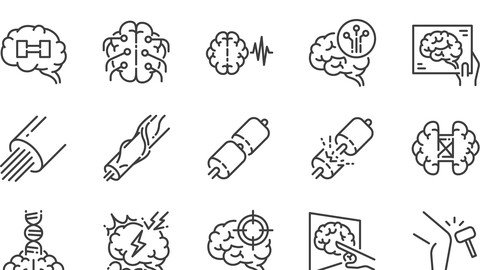 Free Download Introduction To Neurological Examination
Free Download Introduction To Neurological ExaminationPublished 2/2024
MP4 | Video: h264, 1920x1080 | Audio: AAC, 44.1 KHz
Language: English | Size: 1.41 GB | Duration: 0h 54m
neurological examination, practical skills
What you'll learn
Perform the neurological examination of specific components of the nervous system
Understand the anatomical-functional features of the nervous system
Highlight the importance of anatomical areas of the nervous system involved in performing specific task and to define neurological syndromes
Establish the topical diagnosis based on defined clinical syndromes
Requirements
Basic knowledge of neuroanatomy
Description
Neurological examination is a critical component of clinical practice, enabling healthcare professionals to assess and diagnose conditions affecting the nervous system. This systematic process involves evaluating the central and peripheral nervous systems, including the brain, spinal cord, cranial nerves, sensory systems, and motor functions. The examination's comprehensive nature allows clinicians to localize neurological dysfunction, assess its severity, and determine the most likely cause, guiding further diagnostic testing and treatment planning.The neurological examination begins with a thorough patient history, which can provide essential clues about the nature of the neurological issue. This is followed by a series of objective assessments that evaluate various aspects of neurological function. Key components include the assessment of mental status, cranial nerves, motor system, sensory system, reflexes, coordination, and gait. Each of these components plays a vital role in identifying abnormalities and determining their significance in the context of the patient's overall health.The examination of cranial nerves evaluates the twelve nerves that originate in the brain and are responsible for functions ranging from smell and vision to facial movement and swallowing. This part of the examination can pinpoint issues within specific cranial nerves, suggesting localized brain or peripheral nerve damage.Motor system assessment includes muscle strength, tone, and bulk, helping to identify weakness, paralysis, or muscle wasting that could indicate central or peripheral nervous system damage. Sensory examination, on the other hand, tests the patient's ability to perceive touch, pain, temperature, and vibration, highlighting possible damage to sensory pathways.Reflex testing, including both deep tendon and superficial reflexes, can reveal dysfunction in the reflex arcs that traverse the central and peripheral nervous systems. Abnormal reflexes can indicate neurologic disorders or spinal cord injuries. Coordination tests, assessing the ability to perform smooth, accurate movements, can uncover problems in the cerebellum or sensory pathways. Lastly, gait examination can reveal a lot about balance, coordination, and motor function, indicating possible neurologic deficits.The use of neurological examination in clinical practice is invaluable for diagnosing a wide range of conditions, from neurodegenerative diseases like Parkinson's and Alzheimer's to acute events such as strokes and seizures. Moreover, it is crucial in monitoring the progression of neurological disorders and evaluating the effectiveness of treatments. The examination's non-invasive nature makes it an essential first step in the neurological assessment, guiding further diagnostic procedures such as imaging studies or lumbar punctures.In summary, the neurological examination is a cornerstone of neurologic assessment in clinical practice, providing detailed insights into the functioning of the nervous system. Its systematic approach allows clinicians to localize lesions, understand the nature of neurologic disorders, and formulate appropriate management plans, ultimately improving patient care and outcomes.
Overview
Section 1: Introduction
Lecture 1 Introduction
Section 2: Examination of the cranial nerves
Lecture 2 Cranial nerves
Section 3: Sensory system
Lecture 3 Sensory system
Section 4: Motor system
Lecture 4 Motor system examination
Section 5: Cerebellum examination
Lecture 5 Cerebellum examination
Section 6: Meningeal sings
Lecture 6 Examination of meningeal sings
Section 7: Elongation sings
Lecture 7 Examination of elongation sings
Medical students, residents, doctors
Homepage
https://www.udemy.com/course/introduction-to-neurological-examination/
Buy Premium From My Links To Get Resumable Support,Max Speed & Support Me
Introduction To Neurological Examination Torrent Download , Introduction To Neurological ExaminationWatch Free Online , Introduction To Neurological Examination Download Online
Comments

